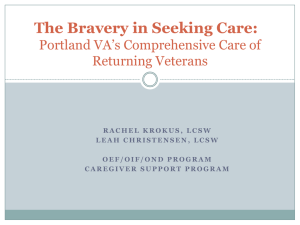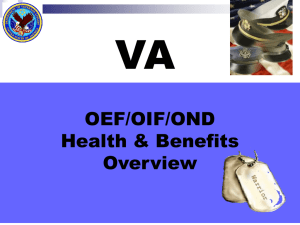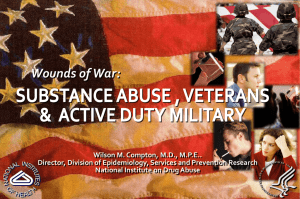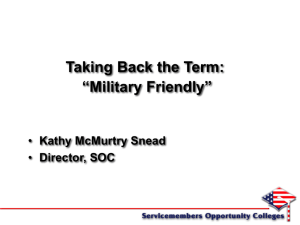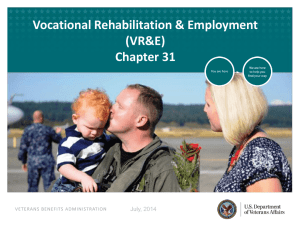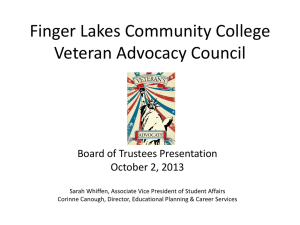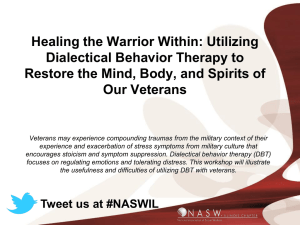VA Outreach Education to Community Mental Health Care Providers
advertisement
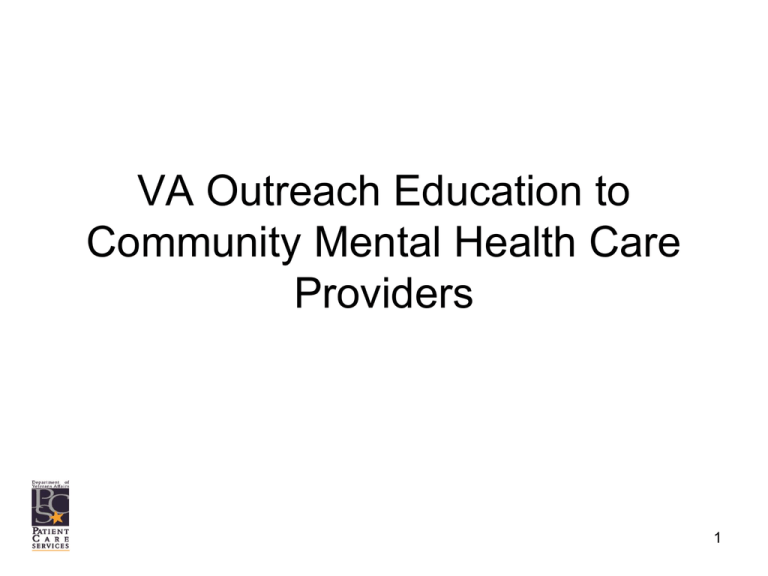
VA Outreach Education to Community Mental Health Care Providers 1 General Eligibility for Care in VHA 2 Who is Eligible for VA Health Care Benefits? • Served in the Active military and discharged or released under conditions other than dishonorable • Former Reservists may be eligible if they served full-time and for operational or support (excludes training) purposes • Former National Guard members may be eligible if they were mobilized by a Federal order 3 Minimum Duty Requirements • Persons enlisting in the Armed Forces after 9/7/80 or who entered on active duty after 10/16/81 are not eligible for VHA benefits unless they completed: – 24 months continuous active service, or – the full period for which they were called or ordered to active duty 4 Excluded from the Minimum Duty Requirements • Minimum active duty requirements do not apply to persons discharged or released from active duty for: – Early out – Hardship – Disability that was incurred or aggravated in line of duty or Veterans with compensable service-connected disability 5 Eligibility for VHA Care as a Combat Veteran 6 Combat Veteran (CV) Authority • Title 38, U.S.C., Section 1710(e)(1)(D) gave authority to provide hospital, medical and nursing home care to Combat Veterans despite insufficient medical evidence to conclude that such condition is attributable to such service. • Veterans who served on active duty in a theater of combat operations during a period of war after the Persian Gulf War or in combat against a hostile force during a period of hostilities after November 11, 1998. • The National Defense Authorization Act of 2008 extended the period in which a combat-theater Veteran may enroll for VA health care and services to five years post discharge/release date. (Please note that this includes Reserve and National Guard Personnel mobilized for Operation Enduring Freedom (OEF), Operation Iraqi Freedom (OIF) and Operation New Dawn (OND).) 7 Combat Veteran Eligibility Definitions Combat Zones Designated by an Executive Order from the President as areas in which the U.S. Armed Forces are engaging or have engaged in combat. Hostilities Defined as conflict in which the members of the Armed Forces are subjected to danger comparable to the danger to which members of the Armed Forces have been subjected in combat with enemy armed forces during a period of war. “Hostile Fire or Imminent Danger Pay” Hostile fire pay refers to pay to anyone exposed to hostile fire or mine explosion. Imminent danger pay is paid to anyone on duty outside the United States area who is subject to physical harm or imminent danger due to wartime conditions, terrorism, civil insurrection, or civil war. 8 Criteria for Combat Veteran Eligibility • Must first meet the definition of a “Veteran” for VA health care benefits. • Combat-theater Veterans who are ineligible to enroll for VA care are referred to a Vet Center for readjustment counseling services, if appropriate, or to a community provider to obtain services at the Veteran's expense. • If a health care emergency exists for an ineligible Veteran, treatment is provided under VA’s humanitarian treatment authority. 9 VHA Services 10 VHA Care Access Points (As of November 3, 2010) • 153 medical centers--At least one in each state, Puerto Rico and the District of Columbia • 951 ambulatory care/community-based outpatient clinics • 47 residential rehabilitation treatment programs • 271 Vet Centers 11 VHA Care Access Points Other Important Numbers (As of November 3, 2010) •Suicide Prevention Hotline 1-800-273-TALK (8255), Press 1 •24/7 National Call Center for Homeless Veterans 1-800-424-3838 12 Key Aspects of VHA Mental Health Care Services • • • • • • • • • Recovery Orientation Evidence-Based Practices and Treatments Continuum of Care Integration of Mental Health Services with Each Other and with Physical Health Care Services Role of Principal Mental Health Care Provider Maximal Access to Care Continuing Care Measurement-Based Outcome Indicators Automated Treatment Adjuncts (e.g. MyHealtheVet) 13 Frequency of VHA Mental Health Screenings • At-risk drinking (annual) • Post-traumatic stress disorder (every year for first five years and once every five years thereafter) • Depression (annual) • Suicide risk (if depression screen is positive) • Military sexual trauma (once) • Traumatic brain injury (once) 14 Operation Enduring Freedom (OEF) Operation Iraqi Freedom (OIF) Operation New Dawn (OND) Experiences Scope of the Issue • More than 1 1/2 million military personnel have served in Iraq and Afghanistan. • “The war in Iraq remains very personal. Over 75% of Soldiers and Marines surveyed reported being in situations where they could be seriously injured or killed; 62-66% knew someone seriously injured or killed; more than one third described an event that caused them intense fear, helplessness or horror.” Office of the Surgeon General Mental Health Advisory Team (MHAT) IV, Final Report Nov 06 16 Understanding the Experience of OEF/OIF/OND 17 “In war, there are no unwounded soldiers.” --Jose Narosky 18 There’s nothing normal about war. There’s nothing normal about seeing people losing their limbs, seeing your best friend die. There’s nothing normal about that, and that will never become normal…” – Lt. Col. Paul Pasquina, MD from the movie "Fighting For Life" 19 Traumatic Events in OEF/OIF/OND Service Members • Multi-casualty incidents (suicide bombers, IEDs (improvised explosive devices), ambushes) • Seeing the aftermath of battle • Handling human remains • Friendly fire • Witnessed or were involved in situations of excessive violence 20 Traumatic Events in OEF/OIF/OND Service Members • Witnessing death/injury of close friend/favored leader • Death/injury of women and children • Feeling helpless to defend or counterattack • Being unable to protect/save another service member or leader • Killing at close range • Killing civilians and avoidable casualties or deaths 21 OEF/OIF/OND Veterans and VA • As of the Fourth Quarter, FY 2010: – 1,250,663 OEF/OIF/OND Veterans eligible for VA services – 50% (625,384) have already sought VA care • Their three most common health issues: – Musculoskeletal – Mental Health – Symptoms, Signs and Ill-Defined Conditions 22 “The most complex and dangerous conflicts, the most harrowing operations, and the most deadly wars, occur in the head.” (Anthony Swafford, Jarhead from PBS video Operation Homecoming) 23 Mental Health Problems in OEF/OIF/OND Veterans • 38% of Soldiers and 31% of Marines report psychological symptoms. • Among the National Guard, the figure rises to 49%. • Further, psychological concerns are significantly higher among those with repeated deployments, a rapidly growing cohort. • Psychological concerns among family members of deployed and returning OEF/OIF/OND Veterans are also an area of concern. Hundreds of thousands of children have experienced deployment of a parent. 24 Mental Health Issues Among OEF/OIF/OND Veterans • Approximately half of OEF/OIF/OND Veterans have provisional mental health diagnoses. The most common of these are PTSD, affective disorders, neurotic disorders, and nondependent abuse of drugs or alcohol, and alcohol dependence. 25 Beyond Mental Health Diagnosis Many problems faced by returning combat Veterans and their families are not so much clinical as they are functional: – – – – – Work Stress/Unemployment Educational/Training Needs Housing Needs Financial and/or Legal Problems) Family Issues • • • • Lack of Social Support Estrangement Family Breakup Kids in trouble 26 Common Themes and Presenting Problems in OEF/OIF/OND Veterans • • • • • • • • • • Marriage, relationship problems Financial hardships Endless questions from family and friends Guilt, shame, anger Feelings of isolation Nightmares, sleeplessness Lack of motivation Forgetfulness Anger Feeling irritable, anxious, feeling “on edge” 27 Positive Aspects of Deployment • Foster maturity • Encourage independence • Strengthen family bonds 28 Some Good Assessment Questions with OEF/OIF/OND Veterans 1. Why did you join the Army, Marine Corps, Navy, etc.? What did you hope to accomplish? 2. Combat tours – Number? When? Where? Military job? Duties in combat zone? 3. Satisfaction with training and deployment preparation 4. Satisfaction with leadership and equipment 5. How do family members feel about the military? 29 The Public Health Model in Treating Veterans 30 Public Health Model • Most Veterans will not develop a mental illness but all Veterans and their families face important readjustment issues • This population-based approach is less about making diagnoses than about helping individuals and families retain a healthy balance despite the stress of deployment 31 Public Health Model • Incorporates the Recovery Model and other principles of the President’s New Freedom Commission on Mental Health – There is a difference between having a problem and being disabled • The public health approach requires a progressively engaging, phase-appropriate integration of services 32 Public Health Model • This program must: – Be driven by the needs of the Service Member/Veteran and his/her family rather than by DoD and VA traditions – Meet prospective users where they live rather than wait for them to find their way to the right mix of our services – Increase access and reduce stigma 33
